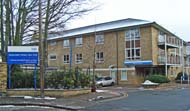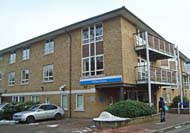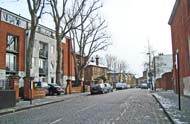General Practitioner
The idea of a GP-led community hospital in Paddington arose from a suggestion from the Community Health Council in the early 1980s, following news of the proposed closure of St Mary's Hospital, Harrow Road.
It had been intended to open the community hospital in 1986 but such was the enthusiasm for the idea that it opened four years early, in a vacant ward in Chepstow Lodge - a temporary location until a permanent site could be found.
The Paddington Community Hospital opened in January 1982 on a two-year trial, funded by the Special Trustees of St Mary's Hospital. It had 24 beds.
All 48 local general practitioners (GPs) were invited to have a contract with the local authority to use the Hospital; all accepted.
The GPs were responsible for providing 24-hour medical care for their patients, either by themselves or by another GP under contract. The Hospital also had 9 trained nurses and 12 auxiliaries, a physiotherapist, an occupational therapist and a social worker. A speech therapist, a dietician and a dentist would visit when required. St Mary's Hospital provided a laboratory service and medications.
The Hospital was managed by a team, consisting of a GP, the Nursing Officer and an administrator, that met once a month. Major policy decisions were made by an Advisory Committee, which met every six weeks, and was made up of administrative, medical and paramedical personnel.
The admissions policy of the Hospital allowed for five categories of patients: acute medical cases; post-operative or other patients suitable for transfer from the District General Hospitals whose GPs had agreed to undertake their continued medical care; selected patients for terminal care; holiday admissions to relieve the patient's relatives from the strain of their duties as carers; and patients for rehabilitation. Children under the age of 16 years were not admitted, nor were obstetric or psychiatric cases, nor those who would have to stay longer than 28 days. Hospital consultant staff were not allowed to admit patients; only GPs had this privilege.
In 1986 the Hospital moved into part of the St Mary's Hospital, Harrow Road buildings, which had recently been vacated. It was joined by the Pembridge Unit, which provided palliative care and had 22 beds.
In 1996 the Pembridge Unit moved to St Charles Hospital when new purpose-built premises for it - the Pembridge Palliative Care Centre - were completed by the Westminster Primary Care Trust.
The Hospital closed in 1998.
Present status (January 2010)
The Hospital building was demolished and replaced by various healthcare-related facilities provided by the Westminster Primary Care Trust and the Central and North West London NHS Foundation Trust.


Athlone House Nursing Home, which itself replaced Athlone House in Hampstead, a geriatric hospital once owned by the Parkside NHS Trust and used for patients from northeast Westminster, is run by Westminster PCT. A Rehabilitation Unit for stroke patients was recently established.


The Paddington Medical Centre. The site also contains Waterview Centre, which provides mental health clinics for people aged between 18 and 65 years.

Looking down Woodfield Road from Harrow Road, the surviving old courtyard is on the left with Athlone House in the far distance.
The community hospital idea was formed from the notion that the majority of patients (70%) did not need the high technology available in a District General Hospital (DGH) and could be treated quite satisfactorily by their GPs. Various studies have shown that the daily cost of an in-patient in a community hospital is a quarter that of the three least expensive DGHs in any area.
The general practitioner hospital is not a new idea. The first 'cottage hospital' opened in 1859 in Cranleigh, Surrey and, by 1934, there were some 600 cottage hospitals in England and Wales, containing some 10,000 beds.
There is no nationally agreed definition of a community hospital, but it can be seen as a reincarnation of the cottage hospital.
Hull SA, Jones I 1995 Is there a demand among general practitioners for inner city community hospitals? Quality in Health Care 4, 214-217.
North NT, Hall DJ and Kearns WE 1984 First year of an inner city general practitioner community hospital. British Medical Journal (Clin Res Ed) 288 (6425), 1209-1211.
www.british-history.ac.uk
Return to home page